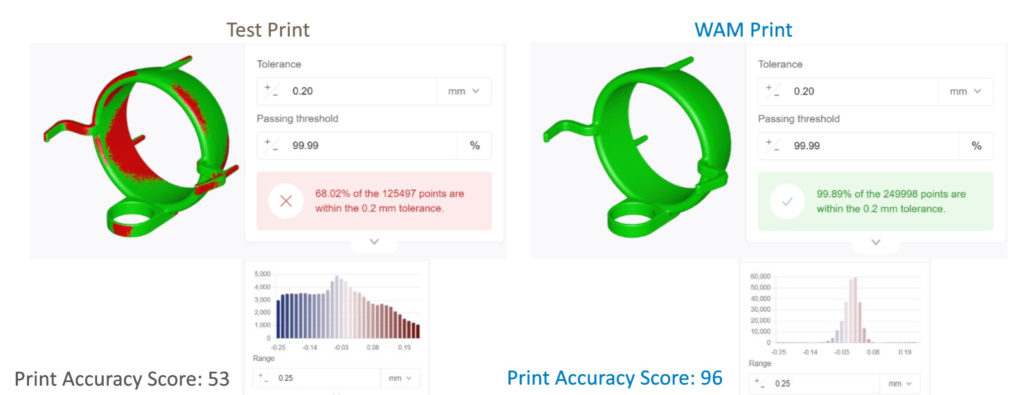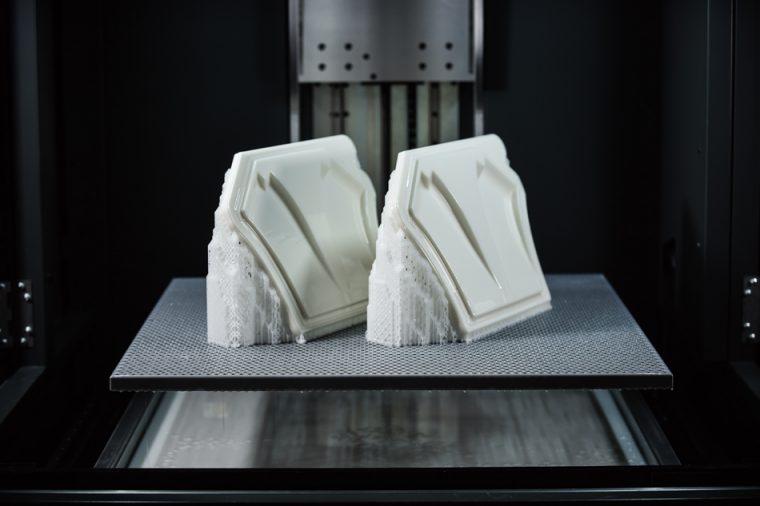Two features crucial to the next phase of additive manufacturing’s (AM) evolution are automation and quality control. Tackling both of these trends from a software and hardware standpoint, Stratasys (NASDAQ: SSYS) has acquired Riven, a developer of cloud-based software for 3D printing quality assurance (QA) and error correction. Additionally, the original equipment manufacturer (OEM) announced the development of an automated system for post-processing parts made with its stereolithography (SLA) and digital light processing (DLP) machines.
3D Printing QA and Compensation
Riven has a unique solution that makes it possible to inspect and correct 3D printed parts through the use of a 3D scanner and artificial intelligence software. Users can quickly scan printed items, which are then matched against the original CAD files, showing any deviations. Using Riven’s Warp Adaptive Modeling (WAM), the CAD models are then adjusted to compensate for the distortions that occurred during printing. Though Riven’s tools have been previously available as a third-party app, Riven’s solutions will now be fully integrated into Stratasys’s GrabCAD Print software.

Riven’s Warp Adaptive Modeling software quickly inspects, diagnoses and automatically corrects deviations between CAD files and actual 3D printed parts. This removes a potentially significant bottleneck in the parts production process that will help Stratasys customers scale adoption of additive manufacturing. Image courtesy of Stratasys.
While other software developers, such as ANSYS and Altair, offer simulation tools that perform similar compensation procedures for printed parts, they are not typically paired with 3D scanning in a similar manner. With powerful computing power, they can estimate distortions that may occur. Riven, however, performs its distortion compensation based on actual, 3D printed parts. On top of that, Riven has developed a solution similar to what software giants offer called Predictive WAM (PWAM).
“It’s been clear to us for some time how much quality is in Stratasys’ DNA, so we knew joining them would be a great fit,” said Riven founder James Page, who will now be a software vice president at Stratasys. “Our combined mission is to ensure that users’ 3D printed reality matches the CAD file each time. By enabling even higher accuracy, we can open new markets and applications.”
Stratasys Introduces Closed-Loop Control
Now, Stratasys will be integrating Riven’s software into a closed-loop 3D printing process. What that will look like is unclear, but, ideally, it would be possible to scan parts during a print job and compensate live. This is a product that would be sought after across the industry, regardless of 3D printer, and, in fact, it is something that several other businesses are developing.

The GrabCAD Additive Manufacturing Platform enables two-way connectivity between 3D printers, additive manufacturing and enterprise applications, and broader Industry 4.0 infrastructure
Velo3D, Markforged, Inkbit, and Sciaky are among the 3D printer OEMs that offer closed-loop quality control for their machines. Sigma Additive Solutions has only just now announced a scan head for laser powder bed fusion metal 3D printers that is said to perform in-process QA. One would think that 3D Systems is developing its own solution via Oqton’s Geomagic Control X and Amphyon software.
“We believe that by identifying state of the art technology platforms and cultivating them under the Stratasys umbrella, companies like Riven can add incremental growth engines to our platform. By integrating Riven’s offerings into our GrabCAD software platform, we will enable more manufacturing customers to adopt Stratasys solutions for end-use parts production,” said Stratasys Vice President of Global Software Shaul Samara. “This important functionality will help ensure production-scale parts are 3D printed accurately and can be inspected quickly within a closed-loop additive manufacturing process. The acquisition of Riven is another example of how we are working to ensure we are providing our customers with complete solutions across the entire additive manufacturing digital thread.”
While Stratasys doesn’t offer as extensive a software suite as Oqton or Materialise, the company has steadily been building up its software solution. The ability to prepare native CAD files directly for printing has been a key benefit of GrabCAD Print. With built-in QA and compensation, the company will have a definitive leg-up on the competition.
Automated Post-Processing
In addition to its purchase of Riven, Stratasys announced the development of the P3 Automated Production Cell, which automatically moves parts between multiple 3D printers and post-processing equipment for cleaning, drying, and curing. The system will be displayed at Formnext, November 15-18 in Frankfurt, Germany, where fleets of Origin One DLP 3D printers will be seen conveying parts to post-processing equipment.

Parts printed with Covestro’s Somos® PerFORM resin with a Neo® stereolithography 3D printer. Stratasys has been dramatically increasing the polymer materials options available to its customers, including agreeing to acquire the additive manufacturing materials business of Covestro. The progress of that strategy will be on full display at Formnext. Image courtesy of Stratasys.
Such tools are being seen as increasingly necessary for the industrialization of AM, as the labor to clean and move parts is intensive. By reducing cost associated with labor, the price-per-part of 3D printed goods is brought down further. For this reason, we’re seeing new post-processing OEMs alongside robotics firms come to the fore. In turn, SmarTech Analysis estimates that the post-processing segment will be worth $1.8 billion by 2031.
Other products that Stratasys plans to unveil include “a new vehicle category” for urban mobility, made as a working prototype by Stratasys customer nFrontier using both 3D printing and traditional manufacturing. The OEM will additionally showcase new materials for its five different AM technologies by its partners, such as Arkema/Kimya, Victrex plc, and Covestro.
Altogether, the company’s presence at Formnext should be an impressive one, but it won’t be alone. We’re weeks away from the event and announcements are already pouring in, suggesting that either everyone is jumping the gun or that this is just the beginning of what will be an immense trade show.
Subscribe to Our Email Newsletter
Stay up-to-date on all the latest news from the 3D printing industry and receive information and offers from third party vendors.
You May Also Like
Gorilla Sports GE’s First 3D Printed Titanium Cast
How do you help a gorilla with a broken arm? Sounds like the start of a bad joke a zookeeper might tell, but it’s an actual dilemma recently faced by...
Nylon 3D Printed Parts Made More Functional with Coatings & Colors
Parts 3D printed from polyamide (PA, Nylon) 12 using powder bed fusion (PBF) are a mainstay in the additive manufacturing (AM) industry. While post-finishing processes have improved the porosity of...
$25M to Back Sintavia’s Largest Expansion of Metal 3D Printing Capacity Since 2019
Sintavia, the digital manufacturing company specializing in mission-critical parts for strategic sectors, announced a $25 million investment to increase its production capacity, the largest expansion to its operations since 2019....
Velo3D Initiates Public Offering in a Bid to Strengthen Financial Foundations and Drive Future Growth
Velo3D (NYSE: VLD) has been among a number of publicly traded 3D printing firms that have attempted to weather the current macroeconomic climate. After posting a challenging financial report for 2023,...































